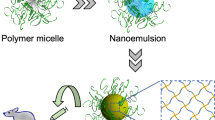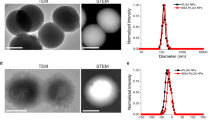Abstract
The stability and size of polymeric nanoparticles are two of the most important parameters determining their pharmacokinetics and tumor/drug accumulation efficiency in cancer-drug delivery. Herein, we report a facile one-pot synthesis of crosslinked nanoparticles (CNPs) with tunable sizes and polyethylene glycol (PEG) shells via click reactions. Simply by adjusting the contents of the macromonomer (PEG monoacrylate) in its reaction with ethylene diacrylate and a crosslinker containing hexa-thiols groups, the sizes of the resulting PEGylated crosslinked nanoparticles could be easily tuned from 10 to 90 nm. These nanoparticle cores could encapsulate hydrophobic drugs such as doxorubicin (DOX), and the unreacted thiol and acrylate groups could be used for drug conjugation or labeling. Thus, the nanoparticles provide a multifunctional platform for drug delivery. In vivo studies showed that the larger nanoparticles (about 83.7 nm) had a much longer blood-circulation time and better tumor-targeting efficiency. One of our most important findings was that the drug encapsulated in the crosslinked nanoparticles, even though little was released at pH 7.4 under in vitro conditions, had much faster blood clearance than the nanoparticles’ carrier, suggesting that drug release in the bloodstream was significant.
Similar content being viewed by others
References
Shen YQ, Jin EL, Zhang B, Murphy CJ, Sui MH, Zhao J, Wang JQ, Tang JB, Fan MH, Van Kirk E, Murdoch WJ. Prodrugs forming high drug loading multifunctional nanocapsules for intracellular cancer drug delivery. J Am Chem Soc, 2010, 132: 4259–4265
Sultana S, Khan MR, Kumar M, Kumar S, Ali M. Nanoparticlesmediated drug delivery approaches for cancer targeting: a review. J Drug Target, 2013, 21: 107–125
Jin EL, Zhang B, Sun XR, Zhou ZX, Ma XP, Sun QH, Tang JB, Shen YQ, Van Kirk E, Murdoch WJ, Radosz M. Acid-active cellpenetrating peptides for in vivo tumor-targeted drug delivery. J Am Chem Soc, 2013, 135: 933–940
Bae Y, Kataoka K. Intelligent polymeric micelles from functional poly(ethylene glycol)-poly(amino acid) block copolymers. Adv Drug Del Rev, 2009, 61: 768–784
Lee KS, Chung HC, Im SA, Park YH, Kim CS, Kim S-B, Rha SY, Lee MY, Ro J. Multicenter phase II trial of Genexol-PM, a Cremophorfree, polymeric micelle formulation of paclitaxel, in patients with metastatic breast cancer. Breast Cancer Res Treat, 2008, 108: 241–250
Kim TY, Kim DW, Chung JY, Shin SG, Kim SC, Heo DS, Kim NK, Bang YJ. Phase I and pharmacokinetic study of Genexol-PM, a cremophorfree, polymeric micelle-formulated paclitaxel, in patients with advanced malignancies. Clin Cancer Res, 2004, 10: 3708–3716
Gong J, Chen M, Zheng Y, Wang S, Wang Y. Polymeric micelles drug delivery system in oncology. J Controlled Release, 2012, 159: 312–323
Sun Q, Radosz M, Shen Y. Challenges in design of translational nanocarriers. J Controlled Release, 2012, 164: 156–169
Rijcken CJ, Snel CJ, Schiffelers RM, van Nostrum CF, Hennink WE. Hydrolysable core-crosslinked thermosensitive polymeric micelles: synthesis, characterisation and in vivo studies. Biomaterials, 2007, 28: 5581–5593
Lu J, Owen SC, Shoichet MS. Stability of self-assembled polymeric micelles in serum. Macromolecules, 2011, 44: 6002–6008
Savic R, Azzam T, Eisenberg A, Maysinger D. Assessment of the integrity of poly(caprolactone)-b-poly(ethylene oxide) micelles under biological conditions: a fluorogenic-based approach. Langmuir, 2006, 22: 3570–3578
Soga O, van Nostrum CF, Snel CJ, Fens MH, Schiffelers RM, Storm G, Hennink WE. In vivo efficacy of paclitaxel-loaded thermosensitive biodegradable polymeric micelles. Dissertation for the Master Degree. Department of Pharmaceutics, Utrecht Institute for Pharmaceutical Sciences, Utrecht, The Netherlands, 2006
Kim SH, Tan JP, Nederberg F, Fukushima K, Colson J, Yang C, Nelson A, Yang YY, Hedrick JL. Hydrogen bonding-enhanced micelle assemblies for drug delivery. Biomaterials, 2010, 31: 8063–8071
Liu R, Li D, He B, Xu X, Sheng M, Lai Y, Wang G, Gu Z. Antitumor drug delivery of pH-sensitive poly(ethylene glycol)-poly(l-histidine-)-poly(l-lactide) nanoparticles. J Controlled Release, 2011, 152: 49–56
Lee ES, Oh KT, Kim D, Youn YS, Bae YH. Tumor pH-responsive flower-like micelles of poly(l-lactic acid)-b-poly(ethylene glycol)-b-poly(l-histidine). J Controlled Release, 2007, 123: 19–26
Talelli M, Iman M, Varkouhi AK, Rijcken CJ, Schiffelers RM, Etrych T, Ulbrich K, van Nostrum CF, Lammers T, Storm G. Core-crosslinked polymeric micelles with controlled release of covalently entrapped doxorubicin. Biomaterials, 2010, 31: 7797–7804
Coimbra M, Rijcken CJ, Stigter M, Hennink WE, Storm G, Schiffelers RM. Antitumor efficacy of dexamethasone-loaded core-crosslinked polymeric micelles. J Controlled Release, 2012, 163: 361–367
Talelli M, Rijcken CJ, Oliveira S, van der Meel R, van Bergen en Henegouwen PM, Lammers T, van Nostrum CF, Storm G, Hennink WE. Nanobody-shell functionalized thermosensitive core-crosslinked polymeric micelles for active drug targeting. J Controlled Release, 2011, 151: 183–192
Wu L, Zou Y, Deng C, Cheng R, Meng F, Zhong Z. Intracellular release of doxorubicin from core-crosslinked polypeptide micelles triggered by both pH and reduction conditions. Biomaterials, 2013, 34: 5262–5272
Chen J, Ouyang J, Kong J, Zhong W, Xing MM. Photo-cross-linked and pH-Sensitive biodegradable micelles for doxorubicin delivery. Acs App Mater Interf, 2013, 5: 3108–3117
Shuai X, Merdan T, Schaper AK, Xi F, Kissel T. Core-cross-linked polymeric micelles as paclitaxel carriers. Bioconjugate Chem, 2004, 15: 441–448
Duong HT, Nguyen TU, Stenzel MH. Micelles with surface conjugated RGD peptide and crosslinked polyurea core via RAFT polymerization. Polym Chem, 2010, 1: 171–182
Zhang L, Bernard J, Davis TP, Barner-Kowollik C, Stenzel MH. Aciddegradable core-crosslinked micelles prepared from thermosensitive glycopolymers synthesized via RAFT polymerization. Macromol Rapid Commun, 2008, 29: 123–129
Alexis F, Pridgen E, Molnar LK, Farokhzad OC. Factors affecting the clearance and biodistribution of polymeric nanoparticles. Mol Pharm, 2008, 5: 505–515
Fang C, Shi B, Pei YY, Hong MH, Wu J, Chen HZ. In vivo tumor targeting of tumor necrosis factor-alpha-loaded stealth nanoparticles: effect of MePEG molecular weight and particle size. Eur J Pharm Sci, 2006, 27: 27–36
Cabral H, Matsumoto Y, Mizuno K, Chen Q, Murakami M, Kimura M, Terada Y, Kano MR, Miyazono K, Uesaka M, Nishiyama N, Kataoka K. Accumulation of sub-100 nm polymeric micelles in poorly permeable tumours depends on size. Nat Nanotech, 2011, 6: 815–823
Ma X, Tang J, Shen Y, Fan M, Tang H, Radosz M. Facile synthesis of polyester dendrimers from sequential click coupling of asymmetrical monomers. J Am Chem Soc, 2009, 131: 14795–14803
Geetha B, Mandal AB, Ramasami T. Synthesis, characterization, and micelle formation in an aqueous solution of methoxypolyethylene glycol macromonomer, homopolymer, and graft copolymer. Macromolecules, 1993, 26: 4083–4088
Sui M, Chen F, Chen Z, Fan W. Glucocorticoids interfere with therapeutic efficacy of paclitaxel against human breast and ovarian xenograft tumors. Int J Cancer, 2006, 119: 712–717
Kalarickal NC, Rimmer S, Sarker P, Leroux JC. Thiol-functionalized poly(ethylene glycol)-b-polyesters: synthesis and characterization. Macromolecules, 2007, 40: 1874–1880
Chan JW, Hoyle CE, Lowe AB, Bowman M. Nucleophile-initiated thiol-michael reactions: effect of organocatalyst, thiol, and ene. Macromolecules, 2010, 43: 6381–6388
Wang N, Dong A, Tang H, Van Kirk EA, Johnson PA, Murdoch WJ, Radosz M, Shen Y. Synthesis of degradable functional poly(ethylene glycol) analogs as versatile drug delivery carriers. Macromol Biosci, 2007, 7: 1187–1198
Dan K, Ghosh S. One-pot synthesis of an acid-labile amphiphilic triblock copolymer and its pH-responsive vesicular assembly. Angew Chem Int Ed, 2013, 52: 1–7
Yan L, Wu W, Zhao W, Qi R, Cui D, Xie Z, Huang Y, Tong T, Jing X. Reduction-sensitive core-cross-linked mPEG-poly (ester-carbonate) micelles for glutathione-triggered intracellular drug release. Polym Chem, 2012, 3: 2403–2412
Lee SJ, Min KH, Lee HJ, Koo AN, Rim HP, Jeon BJ, Jeong SY, Heo JS, Lee SC. Ketal cross-linked poly(ethylene glycol)-poly(amino acid)s copolymer micelles for efficient intracellular delivery of doxorubicin. Biomacromolecules, 2011, 12: 1224–1233
Ghosh S, Basu S, Thayumanavan S. Simultaneous and reversible functionalization of copolymers for biological applications. Macromolecules, 2006, 39: 5595–5597
Shen Y, Jin E, Zhang B, Murphy CJ, Sui M, Zhao J, Wang J, Tang J, Fan M, Van Kirk E. Prodrugs forming high drug loading multifunc tional nanocapsules for intracellular cancer drug delivery. J Am Chem Soc, 2010, 132: 4259–4265
Kelkar SS, Reineke TM. Theranostics: combining imaging and therapy. Bioconjugate Chem, 2011, 22: 1879–1903
Kim J, Lee JE, Lee SH, Yu JH, Lee JH, Park TG, Hyeon T. Designed fabrication of a multifunctional polymer nanomedical platform for simultaneous cancer-targeted imaging and magnetically guided drug delivery. Adv Mater, 2008, 20: 478–483
Wang A, Gao H, Sun Y, Sun Y, Yang YW, Wu G, Wang Y, Fan Y, Ma J. Temperature-and pH-responsive nanoparticles of biocompatible polyurethanes for doxorubicin delivery. Int J Pharm, 2013, 441: 30–39
Pan L, He Q, Liu J, Chen Y, Ma M, Zhang L, Shi J. Nuclear-targeted drug delivery of TAT peptide-conjugated monodisperse mesoporous silica nanoparticles. J Am Chem Soc, 2012, 134: 5722–5725
Mizutani H, Tada-Oikawa S, Hiraku Y, Kojima M, Kawanishi S. Mechanism of apoptosis induced by doxorubicin through the generation of hydrogen peroxide. Life Sci, 2005, 76: 1439–1453
Cheng Y, Yu SL, Wang JJ, Qian HQ, Wu W, Jiang XQ. In vitro and in vivo antitumor activity of doxorubicin-loaded alginic-acid-based nanoparticles. Macromol Biosci, 2012, 12: 1326–1335
Zhang L, Zhu S, Qian L, Pei Y, Qiu Y, Jiang Y. RGD-modified PEG-PAMAM-DOX conjugates: in vitro and in vivo studies for glioma. Eur J Pharm Biopharm, 2011, 79: 232–240
Zhang S, Liu XB, Bawa-Khalfe T, Lu LS, Lyu YL, Liu LF, Yeh ETH. Identification of the molecular basis of doxorubicin-induced cardiotoxicity. Nat Med, 2012, 18: 1639–1642
Author information
Authors and Affiliations
Corresponding author
Electronic supplementary material
Rights and permissions
About this article
Cite this article
Cao, M., Liu, X., Tang, J. et al. Facile synthesis of size-tunable stable nanoparticles via click reaction for cancer drug delivery. Sci. China Chem. 57, 633–644 (2014). https://doi.org/10.1007/s11426-014-5074-2
Received:
Accepted:
Published:
Issue Date:
DOI: https://doi.org/10.1007/s11426-014-5074-2




